Racing - Starting Signals
Go To: Sailing - Racing
Posted on 20 April 2009 14:56
Wouldn't things be so simple if we all just lined up on the start line, someone blew a whistle, and we started? It would be fantastic! However, due to the way boats work, this can never happen. It's easy enough to get people lined up on a running track and send them on one signal, but it doesn't work so well with boats, water, and wind.
So how do we start races? Depending on the type of race, size of the event etc, there are different ways. Some small clubs might use just a sound signal at set intervals outlined in the race briefin; larger clubs might use a flag system with sound signals, which open events tend to use also. These are just some of the more common ways we're now going to look at.
Noise Signals
If you're only sailing with 5 or 6 other people, then it usually isn't worth going to the trouble of a full blown flag system to start races. In this situation, a whistle, hooter or other noise making device can be used to signal race starts. These are usually set off at predetermined intervals, known as the starting sequence, which we will talk about in a moment.
At larger events, a whistle or noise may still be used, usually in conjunction with a flag system (see next section). In this case, the whistle isn't intended as the only signal, it's also used to draw attention to the flags changing.
Flags
Larger events or serious club racing will typically use flags to signal starts. Somewhere near the race start, either on the bank, the starters building, or a large enough boat on the start line, will be a mast, that can have small signal flags hoisted and dropped from it. There are a number of important flags, which we'll discuss first before we talk about how they are used:
There are seven main flags you need to know:
Preparatory P. This is an indication that the starting sequence is in progress, shown in Diagram 1. This is raised during the starting sequence to indicate that the start is in progress. It is lowered 1 minute before the start. We'll discuss the full order of the flags later.
Class Flag. Each boat class will have a class flag specific to that class. This can be used in the starting sequence for single class races.
Postponement. This flag is used to indicate that the race start has been postponed, and any competitors should stand by in the immediate sailing area, unless otherwise instructed, shown in Diagram 2.
Individual Recall X: This flag, known as the cross or x, is used to indicate that an individial boat (or more than one) crossed the line early and must return (see Diagram 3). See the next section on recalls for more information.
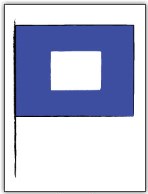
Diagram 1, Preparatory Flag.
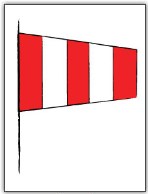
Diagram 2, Postponement Flag
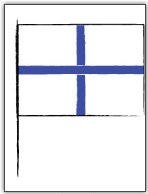
Diagram 3, Individual Recall Flag
General Recall: this flag indiciates the race start will be restarted, as too many boats were over the start line (Diagram 4).
Disqualification: this indicates that a particular boat (or boats) have been disqualified from the race (see Diagram 5).
1 Minute Rule: this flag tells you that if you are On Course Side within 1 minute of the start, you will be disqualified (see Diagram 6).
Bear in mind that events with long start lines (Optimist events can be upwards of 200 boats) may not use sound signals to accompany flags, because not everyone would be able to hear it - in this case, flags become much more important, and you can't get away without understanding them properly!
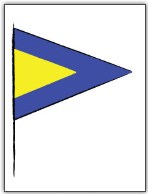
Diagram 4, General Recall Flag.
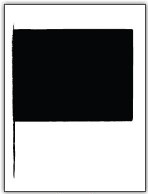
Diagram 5, Disqualification Flag
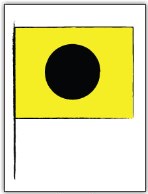
Diagram 6, 1 Minute Rule Flag
Recalls
Recalls are used if someone is over the start line before the race has started. You saw the flags for this in the previous section - and now we'll talk about them. There are different types of recall available for the race officer to use, usually at either his/her discretion, within the rules of the club.
Individual Recall - this signal is raised when one (or more) people are over the start line before the race starts (known as OCS, or On Course Side); the Code Flag "X" is used, with a single sound signal. Due to the size of start lines, it's usually up to you to realise you were over the start line, and do something about it! In this situation, you must cross back over the start line, get behind it again, and then cross again when the race has started. This means if you cross the start line a few seconds early before the start, you must go back and recross it, and waste valuable time.
General Recall - this is used to signal that many people were over the start line, usually too many to use the individual recall signal. In this situation, everyone must return and the race will usually be restarted. The first substitute general recall flag (Diagram 4) is flown, with two sound signals, then lowered with one sound signal one minute before the start sequence begins again.
Disqualification Flag - this indicates that a particular boat is disqualified, as shown in Diagram 5.
Round the Ends - if Code Flag I is flown instead of Code Flag P, then the starting sequence will be the same as usual, and signifies that any boat that's OCS (on course side) within 1 minute of the start must go around the ends of the line to restart. This is not as common as the others.
Starting Sequences
What's a starting sequence? When you're watching track events, such as the 100m, you'll notice the starter calling something along the lines of "ready... set... go!". This is a starting sequence.
How does this apply to sailing? Well because we're in bigger pieces of kit that are ever so slightly more tricky to control than a single running athlete, we need more time to prepare. Our starting sequences for sailing events are usually in the range of 5-10 minutes, and we have a signal at pre-determined intervals during that time, known as the sequence, to help us prepare (because not everyone wears a fancy countdown style race watch).
Probably the most common starting sequence would be 5, 4, 1, go. In this sequence, you would hear a sound signal or whistle blast at 5 minutes, then 4 minutes, then 1 minute, then finally on 0 minutes, or race start. Clearly, you must find out before the race starts which sequence is being used, otherwise you could easily end up starting your race on minute 1, or not being ready at the race start.
We talked about flag signals earlier - the start sequence usually incorporates the flags. Using the 5, 4, 1, go sequence as an example, you would start at 5 minutes with the class flag raised. At 4 minutes, flag clas flag would stay up, and the preparatory (P) flag will join it. At 1 minute, the preparatory flag is lowered, leaving only the class flag raied. Then finally, at 0 minutes, the class flag will come down, and this signals the race start, unless any recall flags go up.
Summary
So as you can see, starting signals can be a tricky business. However, you can make it much easier for yourself by finding out the sequence and what to expect in terms of signals before you get on the water - and you can usually find this out by badgering the race officer as he's busy making final adjustments to the course!